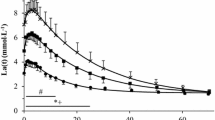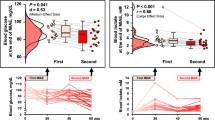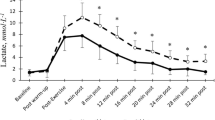Abstract
We investigated the effects of passive and partially active recovery on lactate removal after exhausting cycle ergometer exercise in endurance and sprint athletes. A group of 14 men, 7 endurance-trained (ET) and 7 sprint-trained (ST), performed two maximal incremental exercise tests followed by either passive recovery (20 min seated on cycle ergometer followed by 40 min more of seated rest) or partially active recovery [20 min of pedalling at 40% maximal oxygen uptake (\(\dot V\)O2max) followed by 40 min of seated rest]. Venous blood samples were drawn at 5 min and 1 min prior to exercise, at the end of exercise, and during recovery at 1, 2, 3, 4, 5, 6, 8, 10, 15, 20, 30, 40, 50, 60 min post-exercise. The time course of changes in lactate concentration during the recovery phases were fitted by a bi-exponential time function to assess the velocity constant of the slowly decreasing component (τ2) expressing the rate of blood lactate removal. The results showed that at the end of maximal exercise and during the 1st min of recovery, ET showed higher blood lactate concentrations than ST. Furthermore, ET reached significantly higher maximal exercise intensities [5.1 (SEM 0.5) W · kg−1 vs 4.0 (SEM 0.3) W · kg−1,P < 0.05] and \(\dot V\)O2max [68.4 (SEM 1.1) ml · kg−1 · min−1 vs 55.5 (SEM 5.1) ml · kg−1 · min−1,P < 0.01]. There was no significant difference between the two groups during passive recovery for τ2 During partially active recovery, τ2 was higher than during passive recovery for both groups (P < 0.001), but ET recovered faster and sooner than ST (P < 0.05). Compared to passive recovery, the τ2 measured during partially active recovery was increased threefold in ET and only 1.5-fold in ST. We concluded that partially active recovery potentiates the enhanced ability to remove blood lactate induced by endurance training.
Similar content being viewed by others
References
Bangsbo J, Johansen L, Graham T, Saltin B (1993) Lactate and H− effluxes from human skeletal muscles during intense, dynamic exercise. J Physiol 462: 115–133
Basset DR Jr, Merril PW, Nagle FJ, Agre JC, Sanpedro R (1991) Rate of decline in blood lactate after cycling exercise in endurance-trained and untrained subjects. J Appl Physiol 70: 1816–1820
Bonen A, Belcastro AN (1976)Comparison of self-selected recovery methods on lactic-acid removal rates. Med Sci Sports Exerc 8: 176–178
Bonen A, Campbell CJ, Kirby RI, Belcastro AN (1978) Relationship between slow-twitch muscle fibres and lactic acid removal. Can J Appl Sport Sci 3: 160–162
Brooks GA, Gaesser GA (1980) End points of lactate and glucose metabolism after exhausting exercise. J Appl Physiol 49: 1057–1069
Brooks GS, Mercier J (1994) Balance of carbohydrate and lipid utilization during exercise: the “crossover” concept. J Appl Physiol 76: 2253–2261
Cadefau J, Casademont J, Gran JM, Fernandez J, Balaguer A, Vernet M, Cusso R, Urbano-Marquez A (1990) Biochemical and histochemical adaptation to sprint training in young athletes. Acta Physiol Scand 140: 341–351
Choi D, Cole KJ, Goodpaster BH, Fink WJ, Costill DL (1994) Effect of passive and active recovery on the resynthesis of muscle glycogen. Med Sci Sports Exerc 8: 992–996
Cortes CW, Kreider RB, Al-Mandaloui S, Lamberth J, Johnson KD, Thompson WR, Anderson HN (1988) Lactate clearance during active and passive recovery. Ann Rev Sports Med 4: 26–28
Donovan CM, Brooks GA (1983) Training affects lactate clearance not lactate production. Am J Physiol 244: E83-E92
Donovan CM, Pagliassoti MJ (1990) Enhanced efficiency of lactate removal after endurance training. J Appl Physiol 68: 1053–1058
Francaux MA, Jacqmin PA, Sturbois XG (1993) Variations in lactate apparent clearance during rest and exercise in normal man. Arch Int Physiol Bioch Biophys 101: 303–309
Freund H, Zouloumian P (1981) Lactate after exercise in man. 1. Evolution kinetics in arterial blood. Fur J Appl Physiol 46: 121–133
Freund H, Oyono-Enguelle S (1991) Influence de l'exercise supramaximal sur la cinétique de récupération du lactate. Schweiz Z Sportmed 39 Jahrgang: 65–76
Freund H, Oyono-Enguelle S, Heitz A, Marbach J, Ott C, Zouloumian P, Lampert E (1986) Work rate-dependent lactate kinetics after exercise in humans. J Appl Physiol 61: 932–939
Freund H, Oyono-Enguelle S, Heitz A, Ott C, Marbach J, Pape A (1990) Comparative lactate kinetics after short and prolonged submaximal exercise. Int J Sports Med 11: 284–288
Freund H, Lonsdorfer J, Ono-Enguelle S, Lonsdorfer A, Bogui P (1992) Lactate exchange and removal abilities in sickle cell patients and in untrained and trained healthy humans. J Appl Physic 73: 2580–2587
Gollnick PD, Armstrong RB, Saubert CW IV, Piehl K, Saltin B (1972) Enzyme activity and fiber composition in skeletal muscle of untrained and trained men. J Appl Physiol 33: 312–319
Hatta H, Soma R (1993) Endurance training activates oxidation of lactate during active recovery exercise in mice after supramaximal exercise. Med Sci Sports Exerc S144: 804
Hatta H, Soma R, Atomi Y (1994) Effect of endurance training on oxidation of lactate in mice after supramaximal exercise. Comp Biochem Physiol 101A: 27–30
Holloszy J, Coyle EF (1984) Adaptations of skeletal muscle to endurance exercise and their metabolic consequences. J Appl Physiol 56: 831–838
Jacobs I, Esbjornsson M, Sylven C, Holm I, Jansson E (1987) Sprint training effects on muscle myoglobin, enzymes, fibre types, and blood lactate. Med Sci Sports Exerc 19: 368–374
MacRae HH, Dennis SC, Bosch AN, Noakes TD (1992) Effects of training on lactate production and removal during progressive exercise in humans. J Appl Physiol 72: 1649–1656
McLellan TM, Jacobs I. (1989) Active recovery, endurance training, and the calculation of the individual anaerobic threshold. Med Sci Sports Exerc 5: 586–592
Oyono-Enguelle S, Gartner M, Marbach J, Heitz A, Ott C, Freund H (1989) Comparison of arterial and venous blood lactate kinetics after short exercise. Int J Sports Med 10: 16–24
Oyono-Enguelle S, Marbach J, Heitz A, Ott C, Gartner M, Pape A, Vollmer JC, Freund H (1990) Lactate removal ability and graded exercise in humans. J Appl Physiol 68: 905–911
Oyono-Enguelle S, Freund H, Lonsdorfer J, Pape A (1992) Impaired lactate exchange and removal abilities after supramaximal exercise in humans. Med Sport Sci 34: 140–161
Peronnet F, Morton HR (1994) Plasma lactate concentration increases as a parabola with delay during ramp exercise. Eur J Appl Physiol 68: 228–233
Peters Futre EM, Noakes TD, Raine RI, Terblanche SE (1987) Muscle glycogen repletion during active postexercise recovery. Am J Physiol 253: E305-E311
Sahlin K, Henriksson J (1984) Buffer capacity and lactate accumulation in skeletal muscle of trained and untrained men. Acta Physiol Scand 122: 331–339
Sjödin B (1976) Lactate dehydrogenase in human skeletal muscle. Acta Physiol Scand [Suppl] 436: 1–32
Zouloumian P, Freund H (1981) Lactate after exercise in man II. Mathematical model. Eur J Appl Physiol 46: 135–147
Author information
Authors and Affiliations
Rights and permissions
About this article
Cite this article
Taoutaou, Z., Granier, P., Mercier, B. et al. Lactate kinetics during passive and partially active recovery in endurance and sprint athletes. Europ J Appl Physiol 73, 465–470 (1996). https://doi.org/10.1007/BF00334425
Accepted:
Issue Date:
DOI: https://doi.org/10.1007/BF00334425




